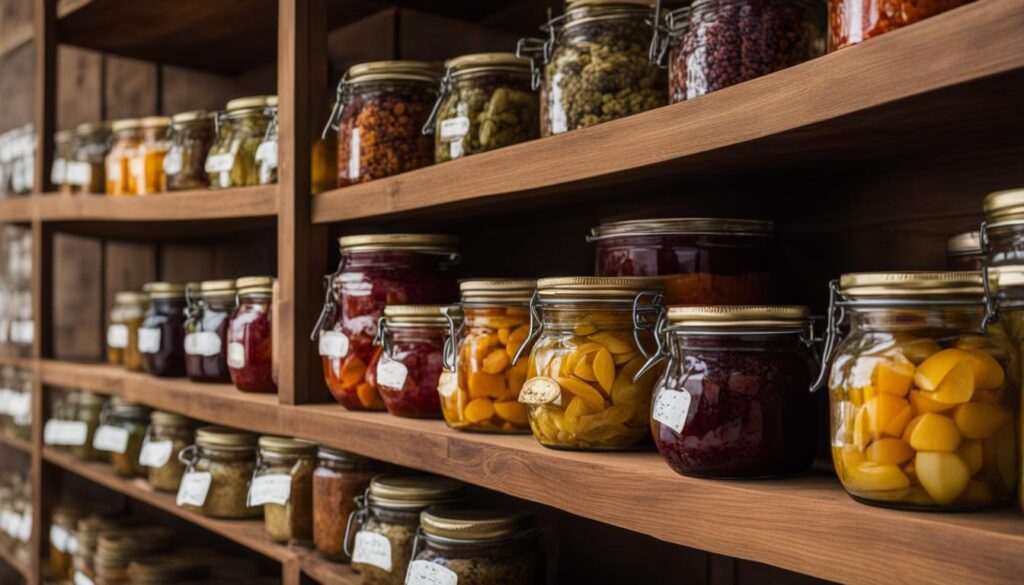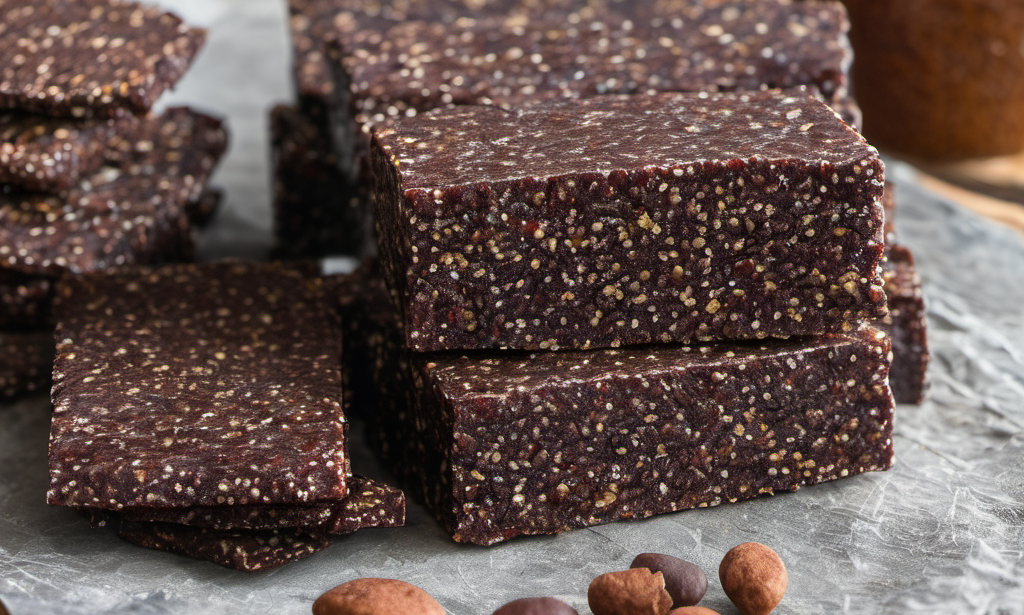In this comprehensive guide, I will provide you with expert tips and strategies for effectively storing pemmican for the long term. Pemmican is a highly nutritious, shelf-stable food that can be a valuable addition to your emergency food supply. Whether you are a seasoned prepper or simply looking for ways to extend the shelf life of your favorite pemmican recipe, this guide will give you all the information you need to preserve the taste and nutritional value of pemmican.
Key Takeaways:
- Pemmican is a portable, high-energy, and highly nutritious food that can last for long periods without refrigeration.
- Proper storage techniques are essential to maintain the taste and nutritional value of pemmican.
- Pemmican has a shelf life of several years to decades if stored correctly.
- Creating a well-stocked emergency food pantry is important to ensure food security.
- Labeling and rotation are key to maintaining freshness and preventing spoilage in your food storage.
The History and Benefits of Pemmican
Pemmican has a rich history, being invented by the Native Americans of North America. It was used by Indian scouts and early western explorers due to its lightweight, compact nature and high nutrient content. Pemmican is packed with protein, carbohydrates, vitamins, and minerals, making it a complete survival superfood. It can provide sustained energy, strength, and overall health when consumed as the sole source of nutrition. The long shelf life of pemmican makes it an ideal food for long-term storage, especially in emergency situations or when access to fresh food is limited.
One of the key benefits of pemmican is its portability. The Native Americans and early explorers relied on pemmican as a convenient and lightweight food source during their journeys. Its compact nature made it easy to carry in small quantities, allowing them to travel long distances without the need for heavy food supplies. This portability continues to be advantageous in modern times, as pemmican can be easily stored in bug out bags, emergency kits, and backpacks for outdoor adventures.
The high-energy content of pemmican is another significant benefit. With its combination of lean dried meat and rendered fat, pemmican provides a concentrated source of calories and sustained energy. This makes it an excellent choice for individuals who engage in physically demanding activities, such as hiking, camping, and survival situations. Pemmican can help replenish energy levels and keep the body fueled for extended periods without access to traditional meals.
| Benefits of Pemmican | Description |
|---|---|
| Long Shelf Life | Pemmican can last for years or even decades if stored properly, making it an ideal food for long-term storage. |
| Complete Nutrition | Pemmican contains a balanced combination of protein, carbohydrates, vitamins, and minerals, ensuring that essential nutrients are provided. |
| Portability | Pemmican is lightweight and compact, making it easy to carry in outdoor activities or emergency situations. |
| High Energy Content | With its concentrated calories from lean meat and fat, pemmican provides sustained energy for physically demanding activities. |
Overall, pemmican holds a significant place in history and offers numerous benefits as a portable high-energy food. Its long shelf life, complete nutrition, and ease of transportation make it a valuable addition to any long-term storage plan or survival kit.
How to Make Pemmican for Long Term Storage
Making pemmican is a straightforward process that involves a few simple steps. By following a pemmican recipe and proper storage methods, you can ensure that your pemmican lasts for an extended period of time while maintaining its taste and nutritional value.
Gathering the Ingredients
To make pemmican, you will need lean meat, such as beef or game, dried berries, and rendered fat, such as tallow or lard. You can choose to use pre-ground meat or grind it yourself using a meat grinder or food processor. Ensure that the meat is fully dried before proceeding with the recipe.
Mixing and Shaping the Pemmican
In a large bowl, combine the dried meat powder and dried berries. The berries add flavor and additional nutrients to the pemmican. Slowly add the hot rendered fat to the mixture, stirring continuously until well combined. The fat helps bind the ingredients together and acts as a preservative.
Once the mixture is thoroughly combined, shape it into small balls or bars. You can use your hands or a mold to achieve the desired shape. Ensure that the pemmican portions are tightly packed to prevent air pockets and extend the shelf life.
Storing the Pemmican
After shaping the pemmican, allow it to cool completely. Once cooled, wrap each portion in wax paper to protect it from moisture and light. Place the wrapped portions in airtight containers, such as ziplock bags or vacuum-sealed bags, to further protect them from environmental factors. Store the pemmican in a cool, dark place, such as a pantry or root cellar, to prevent heat and light exposure.
By following these steps, you can create pemmican that will remain edible and nutritious for long periods of time. Properly stored pemmican can last for several years to decades, making it an ideal food source for emergencies or situations where access to fresh food is limited.
Table: Pemmican Recipe
| Ingredient | Amount |
|---|---|
| Lean meat (beef or game) | 2 pounds |
| Dried berries | 1 cup |
| Rendered fat (tallow or lard) | 1 cup |
Note: This recipe yields approximately 12 pemmican portions.
Tips for Storing Pemmican Properly
When it comes to storing pemmican, there are a few important tips to keep in mind to ensure its longevity and quality. Follow these guidelines to store your pemmican properly:
- Cool completely: Before storing your pemmican, make sure it is completely cooled and set. This helps prevent spoilage and mold growth.
- Wrap in wax paper: To protect the pemmican from moisture and light, wrap each portion in wax paper. This will help maintain its freshness and taste.
- Use airtight containers: Place the wrapped pemmican portions in airtight containers, such as ziplock bags or vacuum-sealed bags. This will further protect them from environmental factors.
- Store in a cool, dark place: To prevent heat and light exposure, store the pemmican in a cool, dark place like a pantry or root cellar. This will help maintain its nutritional value and extend its shelf life.
By following these simple tips, you can ensure that your pemmican stays fresh and delicious for an extended period of time, making it the perfect survival food option.
Table: Comparison of Pemmican Storage Containers
| Container Type | Advantages | Disadvantages |
|---|---|---|
| Ziplock Bags | – Easy to seal and open – Lightweight and portable |
– Not as durable as other containers – Can be punctured or torn |
| Vacuum-Sealed Bags | – Excellent barrier against air and moisture – Extends shelf life |
– Requires a vacuum sealer machine – Can be more expensive |
| Mylar Bags | – Provides excellent protection against oxygen and light – Durable and reusable |
– Requires heat sealing equipment – Can be bulkier to store |
| Mason Jars | – Transparent, allowing visibility of contents – Reusable and versatile |
– Can be heavy and breakable – Requires careful handling |
Remember, choosing the right storage container for your pemmican is essential for maintaining its quality and shelf life. Consider factors such as durability, portability, and cost when making your selection.
Pemmican as a Survival Food
When it comes to survival food, pemmican is often hailed as the ultimate choice. With its long shelf life, portability, and high nutritional value, it is no wonder that pemmican has earned a reputation as the ultimate survival superfood. Whether you are preparing for emergencies, natural disasters, or simply looking to stock up for long-term food storage, pemmican should be at the top of your list.
Pemmican is a lightweight and compact food source that can provide sustenance during extended periods without access to traditional food sources. It is packed with protein, carbohydrates, vitamins, and minerals, offering the essential nutrients needed to maintain energy, strength, and overall health. Its high nutrient content combined with its long shelf life makes pemmican an ideal choice for those seeking a reliable and nutritious food source in times of need.
When stored properly, pemmican can last for years or even decades without refrigeration. This makes it an excellent option for long-term food storage. By following proper storage techniques, such as wrapping the pemmican portions in wax paper and storing them in airtight containers in a cool, dark place, you can ensure that your pemmican remains fresh and maintains its nutritional value over time.
Benefits of Pemmican as a Survival Food
- Long shelf life: Pemmican can last for years or even decades without refrigeration.
- Portability: Pemmican is lightweight and compact, making it easy to carry in emergency situations.
- High nutritional value: Pemmican is packed with protein, carbohydrates, vitamins, and minerals, offering essential nutrients for survival.
- Versatility: Pemmican can be consumed as the sole source of nutrition or used as a supplement to other foods.
| Survival Food | Long Shelf Life | Portability | High Nutritional Value |
|---|---|---|---|
| Pemmican | ✓ | ✓ | ✓ |
| Canned Goods | ✓ | ✓ | ✓ |
| Dried Staples | ✓ | ✓ | ✓ |
Alternatives to Homemade Pemmican

While homemade pemmican is an excellent option for long-term food storage, there are also commercially available alternatives to consider. These alternatives provide convenience and a wide range of options to meet different dietary preferences and nutritional needs. When selecting the best commercially available pemmican or alternative long-term storage foods, it is important to consider factors such as shelf life, taste, nutritional value, and ease of preparation.
One popular option is freeze-dried or dehydrated meals specifically designed for long-term storage and survival situations. These meals come in a variety of flavors and varieties, providing a diverse and convenient food supply. They are lightweight, easy to store, and require minimal preparation. Simply add water, and you have a nutritious meal ready to eat.
An additional alternative is canned meats, such as tuna or chicken. These have a long shelf life and provide a good source of protein. They can be easily incorporated into meals or eaten on their own. Other options include protein bars, meal replacement shakes, and dried fruits and nuts, which offer a balance of nutrients and long shelf life.
| Alternative Long-Term Storage Foods | Shelf Life | Taste | Nutritional Value | Ease of Preparation |
|---|---|---|---|---|
| Freeze-dried Meals | Up to 25 years | Varies by brand and flavor | Varies by brand and flavor | Requires water and heat source |
| Canned Meats | 2 to 5 years | Varies by type and brand | Provides protein | Ready to eat, no preparation needed |
| Protein Bars | Up to 1 year | Varies by brand and flavor | Provides protein and other nutrients | Ready to eat, no preparation needed |
| Meal Replacement Shakes | 1 to 2 years | Varies by brand and flavor | Provides balanced nutrition | Requires water or liquid for mixing |
| Dried Fruits and Nuts | Up to 1 year | Naturally sweet and nutty flavors | Provides vitamins, minerals, and healthy fats | Ready to eat, no preparation needed |
When considering alternative long-term storage foods, it is important to evaluate their suitability for your specific needs and preferences. Read reviews, check the nutritional information, and consider conducting taste tests before making a final decision. It is also recommended to regularly rotate and replenish your stock of alternative options to ensure freshness and optimal nutrition.
Creating a Well-Stocked Emergency Food Pantry
In addition to pemmican, it is important to have a well-stocked emergency food pantry to ensure food security in unexpected situations. A well-prepared pantry includes a variety of long-term storage foods that can provide sustenance during emergencies, natural disasters, or other situations where access to fresh food is limited.
A well-stocked emergency food pantry should include a combination of canned goods, dried staple foods, protein sources, herbs and spices, condiments, sweeteners, and snack foods. It is crucial to choose foods with long shelf lives, easy storage methods, and nutritional value. Consider your family’s dietary restrictions, preferences, and nutritional needs when selecting items for your pantry.
To maintain a well-stocked pantry, regularly rotate and replace older items to ensure freshness and prevent spoilage. Use the first in first out (FIFO) method when consuming items to ensure older ones are used before newer ones. Regularly check expiration dates and inspect stored food for signs of spoilage or damage.
| Food Category | Examples |
|---|---|
| Canned Goods | Canned vegetables, fruits, soups, and meats |
| Dried Staple Foods | Rice, pasta, beans, oats, and flour |
| Protein Sources | Canned fish, poultry, and beans |
| Herbs and Spices | Salt, pepper, garlic powder, and dried herbs |
| Condiments | Ketchup, mustard, mayonnaise, and salad dressings |
| Sweeteners | Sugar, honey, and maple syrup |
| Snack Foods | Granola bars, nuts, dried fruits, and jerky |
A well-stocked emergency food pantry provides peace of mind and ensures that you have a reliable food supply during challenging times. By organizing and labeling your food storage, you can maximize its effectiveness and maintain a fresh and ready supply of nourishment for yourself and your family.
The Importance of Labeling and Rotation
In order to maintain the freshness and quality of your long-term food storage, proper labeling and rotation techniques are essential. By implementing effective organizational strategies, you can ensure that your food supply remains safe, accessible, and up-to-date. Here are some key considerations for labeling and rotation:
Labeling
- Clearly label shelves, containers, and individual items with the name and expiration date of the food.
- Use waterproof and smudge-proof labels to prevent them from becoming illegible over time.
- Consider categorizing your storage area by food type or meal category to make it easier to locate specific items.
Rotation
- Adopt the “first in, first out” (FIFO) method when consuming food from your storage. Use older items before newer ones to ensure everything gets used in a timely manner.
- Regularly check expiration dates and remove any expired items to maintain the freshness and quality of your food supply.
- Inspect stored food for signs of spoilage or damage, such as odd smells, discoloration, or bulging packaging. Discard any items that show these signs.
By labeling your food storage and practicing proper rotation techniques, you can effectively manage your long-term food supply and maximize its shelf life. This not only helps maintain food freshness but also ensures that you have a well-organized and reliable source of nourishment in times of need. Remember to regularly monitor and update your inventory to keep your food storage well-maintained and ready for any situation.
Table: Comparison of Food Rotation Methods
| Method | Advantages | Disadvantages |
|---|---|---|
| FIFO (First In, First Out) |
|
|
| FEFO (First Expired, First Out) |
|
|
| LIFO (Last In, First Out) |
|
|
Conclusion
In conclusion, pemmican is a highly nutritious and long-lasting food option for long-term storage. Its portable nature, high energy content, and rich history make it a valuable choice for emergency situations or when access to fresh food is limited.
By following proper storage techniques, such as cooling, wrapping, and storing in airtight containers, pemmican can have a shelf life of several years to decades. This makes it a reliable source of sustenance for extended periods of time.
In addition to pemmican, it is crucial to create a well-stocked emergency food pantry that includes a variety of long-term storage foods. Labeling and rotation are essential for maintaining freshness and preventing spoilage in your food storage.
By implementing these strategies and considering commercially available alternatives, you can ensure food security and have peace of mind knowing that you have a reliable and nutritious food supply to rely on when needed.
FAQ
What is pemmican?
Pemmican is a portable, high-energy, highly nutritious food traditionally made from dried meat, rendered fat, and crushed berries.
How long can pemmican last without refrigeration?
When stored properly, pemmican can have a shelf life of several years to decades.
What nutrients does pemmican provide?
Pemmican is packed with protein, carbohydrates, vitamins, and minerals, making it a complete survival superfood.
How do you make pemmican?
Pemmican is made by drying lean meat, grinding it into a powder, and mixing it with hot rendered fat and dried berries.
How should pemmican be stored?
Pemmican should be completely cooled and set before storing. It should be wrapped in wax paper, placed in airtight containers, and stored in a cool, dark place.
Why is pemmican considered an ideal survival food?
Pemmican is lightweight, compact, and nutrient-dense, making it a reliable source of sustenance during emergencies or when access to fresh food is limited.
Are there alternatives to homemade pemmican for long-term storage?
Yes, there are commercially available freeze-dried or dehydrated meals designed for long-term storage and survival situations.
What should be included in a well-stocked emergency food pantry?
A well-stocked emergency food pantry should include a variety of long-term storage foods such as canned goods, dried staple foods, protein sources, and snack foods.
Why is labeling and rotation important in maintaining long-term food storage?
Labeling and rotation help ensure that older items are used first, preventing food waste and maintaining a fresh food supply.

